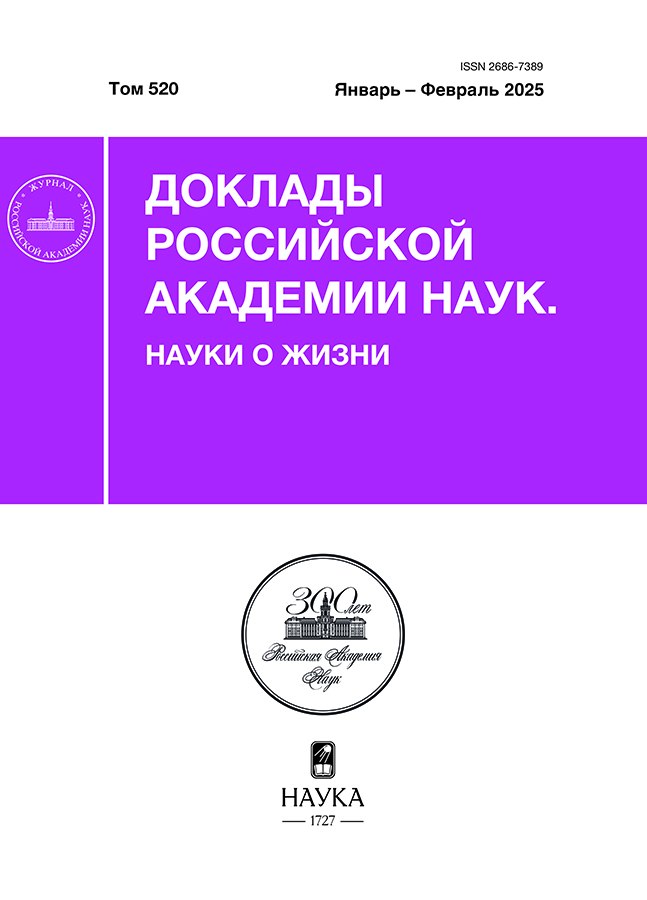Expression of Hox cluster genes in arly larval development of sea urchin Strongylocentrotus intermedius (Echinodermata, Echinoidea)
- Авторлар: Ageenko N.V.1, Ezhova O.V.2, Kiselev K.V.3, Lukinykh A.I.2, Malakhov V.V.2
-
Мекемелер:
- A.V. Zhirmunsky National Scientific Center of Marine Biology, Far Eastern Branch of the Russian Academy of Sciences (NSCMB FEB RAS)
- Lomonosov Moscow State University
- Federal Scientific Center of the East Asia Terrestrial Biodiversity, Far Eastern Branch of the Russian Academy of Sciences
- Шығарылым: Том 520, № 1 (2025)
- Беттер: 14-18
- Бөлім: Articles
- URL: https://cijournal.ru/2686-7389/article/view/682017
- DOI: https://doi.org/10.31857/S2686738925010034
- EDN: https://elibrary.ru/tdjqkg
- ID: 682017
Дәйексөз келтіру
Аннотация
The quantitative assessment of the expression of 11 genes of the Hox cluster of the sea urchin Strongylocentrotus intermedius (SiHox1, 2, 3, 5, 6, 7, 8, 9/10, 11/ 13a, 11/13b, 11/13c) in the larvae at early developmental stages (blastula – 13 hours post fertilization (h.p.f.), gastrula – 35 h.p.f., prism stage – 46 h.p.f., echinoplutei – 4 and 9 days p.f.) was carried out. At the blastula stage, the expression of the SiHox-7, 11/13b, and 11/13c is observed; as for the latter the early activation was noted for the first time for regular sea urchins. At the gastrula and prism stages, a very low level of expression is observed. At the pluteus stage, there is significant increase of the expression of all Hox cluster genes. Breakages of temporal colinearity during the expression of Hox genes in echinoderms are discussed.
Негізгі сөздер
Толық мәтін
Авторлар туралы
N. Ageenko
A.V. Zhirmunsky National Scientific Center of Marine Biology, Far Eastern Branch of the Russian Academy of Sciences (NSCMB FEB RAS)
Email: olga_ejova@mail.ru
Ресей, Vladivostok
O. Ezhova
Lomonosov Moscow State University
Хат алмасуға жауапты Автор.
Email: olga_ejova@mail.ru
Биологический факультет
Ресей, MoscowK. Kiselev
Federal Scientific Center of the East Asia Terrestrial Biodiversity, Far Eastern Branch of the Russian Academy of Sciences
Email: olga_ejova@mail.ru
Ресей, Vladivostok
A. Lukinykh
Lomonosov Moscow State University
Email: olga_ejova@mail.ru
Биологический факультет
Ресей, MoscowV. Malakhov
Lomonosov Moscow State University
Email: olga_ejova@mail.ru
Academician of the RAS
Ресей, MoscowӘдебиет тізімі
- Peterson K.J., Arenas-Mena C., Davidson E.H. The A/P axis in echinoderm ontogeny and evolution: evidence from fossils and molecules // Evolution and Development. 2000. Vol. 2. No. 2. P. 93–101.
- Рожнов С.В. Переднезадняя ось иглокожих и перемещение рта в их историческом и индивидуальном развитии // Изв. РАН. Сер. биол. 2012. № 2. C. 203–212.
- Wada H., Garcia-Fernàndez J., Holland P.W. Colinear and segmental expression of amphioxus Hox genes // Developmental Biology. 1999. Vol. 213. No. 1. P. 131–141.
- David B., Mooi R. How Hox genes can shed light on the place of echinoderms among the deuterostomes // EvoDevo. 2014. Vol. 5. 22.
- Martinez P., Rast J.P., Arenas-Mena C., et al. Organization of an echinoderm Hox gene cluster // Proc. Natl. Acad. Sci. USA. 1999. Vol. 96. P. 1469–1474.
- Cameron R.A., Rowen L., Nesbitt R., et al. Unusual gene order and organization of the sea urchin Hox cluster // J. Exp. Zool. B: Mol. Dev. Evol. 2006. Vol. 306. P. 45–58.
- Mito T., Endo K. PCR survey of Hox genes in the crinoid and ophiuroid: evidence for anterior conservation and posterior expansion in the echinoderm Hox gene cluster // Mol. Phylogenet. Evol. 2000. Vol. 14. No. 3. P. 375–388.
- Aronowicz J., Lowe C.J. Hox gene expression in the hemichordate Saccoglossus kowalevskii and the evolution of deuterostome nervous systems // Integr. Comp. Biol. 2006. Vol. 46. P. 890–901.
- Freeman R. Ikuta T., Wu M., et al. Identical genomic organization of two hemichordate Hox clusters // Curr. Biol. 2012. Vol. 22. No. 21. P. 2053–2058.
- Arenas-Mena C., Martinez P., Cameron R.A., et al. Expression of the Hox gene complex in the indirect development of a sea urchin // Proc. Natl. Acad. Sci. USA. 1998. Vol. 95. P. 13062–13067.
- Tsuchimoto J., Yamaguchi M. Hox expression in the direct-type developing sand dollar Peronella japonica // Dev. Dyn. 2014. Vol. 243. P. 1020–1029.
- Ageenko N.V., Kiselev K.V., Odintsova N.A. Expression of pigment cell-specific genes in the ontogenesis of the sea urchin Strongylocentrotus intermedius // J. Evid.-Based Complementary Altern. Med. 2011. 730356.
- Tu Q., Cameron R.A., Worley K.C., et al. Gene structure in the sea urchin Strongylocentrotus purpuratus based on transcriptome analysis // Genome Res. 2012. Vol. 22. No. 10. P. 2079–2087.
- Tu Q., Cameron R.A., Davidson E.H. Quantitative developmental transcriptomes of the sea urchin Strongylocentrotus purpuratus // Dev. Biol. 2014. Vol. 385. No. 2P. 160–167.
- Angerer L.M., Dolecki G.J., Gagnon M.L., et al. Progressively restricted expression of a homeo box gene within the aboral ectoderm of developing sea urchin embryos // Genes Dev. 1989. Vol. 3. No. 3. P. 370–383.
- Dobias S.L., Zhao A.Z., Tan H., et al. SpHbox7, a new Abd-B class homeobox gene from the sea urchin Strongylocentrotus purpuratus: insights into the evolution of hox gene expression and function // Dev. Dyn. 1996. Vol. 207. No. 4. P. 450–460.
- Kikuchi M., Omori A., Kurokawa D., et al. Patterning of anteroposterior body axis displayed in the expression of Hox genes in sea cucumber Apostichopus japonicus // Development Genes and Evolution. 2015. Vol. 225. No. 5. P. 275–286.
- Hara Y., Yamaguchi M., Akasaka K., et al. Expression patterns of Hox genes in larvae of the sea lily Metacrinus rotundus // Development Genes and Evolution. 2006. Vol. 216. No. 12. P. 797–809.
Қосымша файлдар











